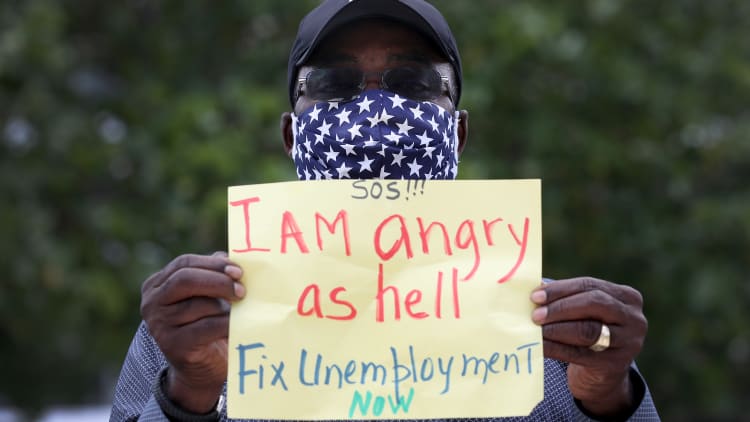The latest jobless numbers from the Department of Labor indicate that nearly half of all workers receiving unemployment benefits are supported by Pandemic Unemployment Assistance (PUA), which covers individuals not traditionally eligible for aid, including self-employed, freelance, gig and part-time workers.
More than 29 million Americans were collecting unemployment benefits in mid-August, according to the latest available data, including 13.5 million individuals claiming PUA — a sharp increase from the 10.9 million people collecting PUA the week prior. Last week, 833,352 people filed new regular unemployment claims and 759,482 people filed new PUA claims, according to unadjusted figures.
PUA, established under the March CARES Act, is set to expire at the end of the year. It provides up to 39 weeks of unemployment benefits to those who are not usually eligible for regular state aid but lose work, through no fault of their own, due to the coronavirus pandemic. It also provides supplemental weeks of aid to individuals who live in states that offer, through regular aid and 13 weeks of Pandemic Emergency Unemployment Compensation (PEUC), less than 39 weeks of jobless benefits total.
The unprecedented expansion of unemployment benefits in March ensures some groups disproportionately impacted by the coronavirus receive aid, including Black workers who are overrepresented in self-employed, contract or part-time roles and are more likely to experience longer stints of joblessness. Its expiration at the end of the year could severely impact some of the most vulnerable workers and result in a slow economic recovery, says Howard University professor and AFL-CIO chief economist William Spriggs.
"The share of workers getting Pandemic Unemployment Assistance clearly points to the gap in the regular state programs that ignore workers and a number of low-wage industries," Spriggs tells CNBC Make It. "It shows we could and can devise access to programs to insure low-wage workers."
In May, the House of Representatives passed the HEROES Act, which includes continuing the expired $600 weekly benefit and extending federal PUA and PEUC enhancements to March 31, 2021. The Senate failed to take up the bill and instead introduced its own HEALS Act in late July, with a reduced weekly boost to state benefits and timeline that would allow all unemployment enhancements to expire at the end of December 2020.
Congress and White House officials did not make progress on a new stimulus package before the Senate adjourned for recess until Labor Day.
On August 8, President Trump signed a memorandum to create a new $300 supplemental wage to some jobless workers, including those receiving PUA benefits of at least $100 per week. The program has been taken up in most states, but funding may be running out soon.
Spriggs says voters should urgently be thinking about the December 31 expiration of existing relief efforts, given lawmakers' willingness to let the $600 benefit expire at the end of July. "If people aren't discussing how we'll extend that, it's a real danger," Spriggs says.
He adds that, for people whose economic lifelines through jobless benefits could be in jeopardy, "this election means everything to them. They need to be paying attention to who in Congress is taking the unemployment situation seriously, and they need to understand their vote matters."
The Senate is expected to reconvene next week and discuss a revised "skinny bill" that would continue federal jobless benefits at $300 to $400 per week, though it's unclear how long enhanced unemployment aid will last. Critics say the proposal doesn't do enough to support Americans through through other relief measures, including rental and food assistance, as well as aid to state and local governments.
On January 1, 2021, unless Congress acts to pass a new stimulus package, only workers who traditionally qualify for unemployment benefits can continue to receive aid in the new year. If a worker is eligible for traditional unemployment insurance but was enrolled in PEUC or PUA for additional weeks of aid, they may be able to tap a new window of extended benefits offered by their state, ranging from six to 20 additional weeks, come January. Every state except Idaho and South Dakota is currently offering a period of extended benefits.
Check out: Americans spend over $5,000 a year on groceries—save hundreds at supermarkets with these cards
Don't miss:
Nearly half of all furloughed workers now believe their temporary layoff will become permanent
Just 13% of Black people out of work are getting unemployment benefits during the pandemic
'We will lose everything:' Americans express frustration at Congress recessing with no stimulus deal



